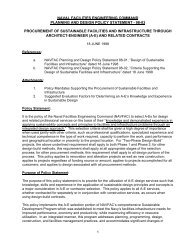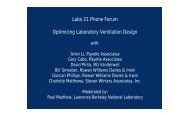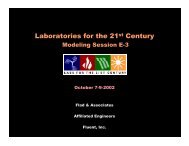Whitehead Biomedical Research Building at Emory University ... - I2SL
Whitehead Biomedical Research Building at Emory University ... - I2SL
Whitehead Biomedical Research Building at Emory University ... - I2SL
You also want an ePaper? Increase the reach of your titles
YUMPU automatically turns print PDFs into web optimized ePapers that Google loves.
L A B S F O R T H E 2 1 S T C E N T U R Y 5An energy analysis was performed to compare thebuilding as designed with a base case building meetingAmerican Society of He<strong>at</strong>ing, Refriger<strong>at</strong>ing, and Air-Conditioning Engineers/Illumin<strong>at</strong>ing Engineering Societyof North America (ASHRAE/IENSA) standard 90.1-1999.Expected annual savings include 2161 MBtu of he<strong>at</strong>ingfuel and 3.4 million kWh of electricity, or $167,730 inenergy costs. This takes into account the savings fromdaylighting controls and high-efficiency equipment. Andit transl<strong>at</strong>es into a 22.2% overall energy savings, whencompared with the base case.System design decisions were made on a life-cyclecost basis, and a “value management” process wasemployed to ensure th<strong>at</strong> cost-reduction decisions didnot reduce the facility’s long-term value to the university.For the energy recovery system alone, the internal r<strong>at</strong>e ofreturn on a $450,000 investment yielding $136,028 annuallyover 10 years would be 28% (this assumes no escal<strong>at</strong>ionin utility costs over th<strong>at</strong> time). If costs and benefits of otherefficiency measures were taken into consider<strong>at</strong>ion, theactual r<strong>at</strong>e of return rel<strong>at</strong>ive to a code-compliant facilitywould be significantly gre<strong>at</strong>er.The ventil<strong>at</strong>ed cages used in the viviarium provideseveral opportunities for energy and m<strong>at</strong>erial savingsand health benefits to occupants. The system used in the<strong>Whitehead</strong> <strong>Building</strong> provides supply and exhaust airdirectly to and from each individual cage. And the systemallows a reduction in the ventil<strong>at</strong>ion air r<strong>at</strong>e from 15 ACHto 10 ACH. In new construction, this could allow a reductionin the size of the fans serving the vivarium. The ventil<strong>at</strong>edracks also keep the corncob bedding drier, so th<strong>at</strong> itmust be changed only every 14 days r<strong>at</strong>her than every7 days. The ventil<strong>at</strong>ed racks provide health benefits forworkers and reduce the spread of allergens.Daylighting and LightingNinety percent of the building’s lab and office spacesline the perimeter and include windows to the outside.Thus, the vast majority of occupied rooms receive n<strong>at</strong>urallight during the day. The building’s perimeter electriclighting system is tied to an on/off switch controlled by aphotocell (with manual overrides) to control the row oflights parallel to the window. These lights are autom<strong>at</strong>icallyswitched off when there is adequ<strong>at</strong>e n<strong>at</strong>ural lighting.Each 2500-ft 2 zone in lab areas has six 3-way switchesto control lights. Individual offices and small rooms usemotion detector lighting controls. The lighting inside thebuilding uses T-8 lamps with electronic ballasts in twolamp,1x4 recessed parabolic fixtures loc<strong>at</strong>ed directlyover each bench. The lighting level <strong>at</strong> bench top is 75 footcandles.W<strong>at</strong>er Efficiency<strong>Emory</strong> <strong>University</strong> incorpor<strong>at</strong>ed several w<strong>at</strong>er-savingmeasures into this project. These include storm-w<strong>at</strong>erharvesting for irrig<strong>at</strong>ion, a condens<strong>at</strong>e recovery systemfor make-up w<strong>at</strong>er in cooling towers, and advancedcage-washing techniques.The building’s storm-w<strong>at</strong>er harvesting system capturesw<strong>at</strong>er from the roof and the outdoor plaza andmoves it to a large retention vault bene<strong>at</strong>h the plaza. Thew<strong>at</strong>er is then filtered and reused for site irrig<strong>at</strong>ion. FultonCounty required <strong>Emory</strong> to build a retention vault to slowdown the runoff of storm w<strong>at</strong>er from the roof and thesite. When they decided to go for LEED certific<strong>at</strong>ion, the<strong>Emory</strong> design team made the underground retentionvault 3 feet deeper so it would hold about 70,000 gallonsof w<strong>at</strong>er. They also added a filter, a pump, and a bit ofpiping to connect this c<strong>at</strong>chment area into the site’sirrig<strong>at</strong>ion system. Figure 2 shows the retention vaultunder construction.In addition, the design team recognized th<strong>at</strong> the airconditioningsystem would cre<strong>at</strong>e a tremendous amountof condens<strong>at</strong>e w<strong>at</strong>er. So, they decided to pipe the condens<strong>at</strong>efrom the AHUs and chilled w<strong>at</strong>er coils back intonearby cooling towers for use as make-up w<strong>at</strong>er. Thissystem not only conserves w<strong>at</strong>er, it also diverts an estim<strong>at</strong>ed2.5 million gallons a year from the county’s sanitarysewer system, saving energy and money as well.The vivarium includes a st<strong>at</strong>e-of-the-art, autom<strong>at</strong>edcage-washing system. The cage washer, which was manufacturedin Finland, is one of the first ones installed in theUnited St<strong>at</strong>es. It saves energy, w<strong>at</strong>er, and chemicals byrecycling w<strong>at</strong>er through four stages of cleaning using acounter-current rinsing process. In counter-current rinsing,the flow of rinse w<strong>at</strong>er for cage washing is the oppo-Figure 2. Retention vaultStuart Lewis, HOK/PIX












